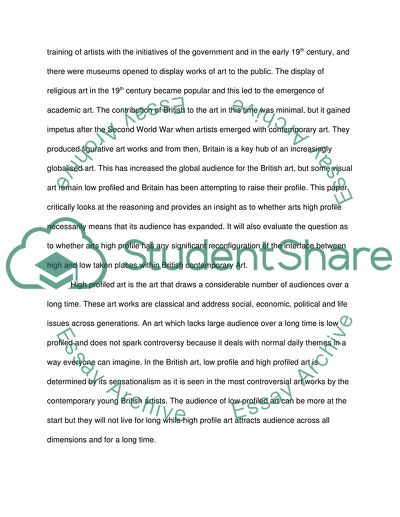Cite this document
(“Art and the British Empire Essay Example | Topics and Well Written Essays - 2500 words - 1”, n.d.)
Art and the British Empire Essay Example | Topics and Well Written Essays - 2500 words - 1. Retrieved from https://studentshare.org/visual-arts-film-studies/1464532-does-arts-high-profile-necessarily-mean-that-its-audience-has-expanded-and-has-any-significant-reconfiguration-of-the-interface-between-high-and-low-taken-place-within-british-art
Art and the British Empire Essay Example | Topics and Well Written Essays - 2500 words - 1. Retrieved from https://studentshare.org/visual-arts-film-studies/1464532-does-arts-high-profile-necessarily-mean-that-its-audience-has-expanded-and-has-any-significant-reconfiguration-of-the-interface-between-high-and-low-taken-place-within-british-art
(Art and the British Empire Essay Example | Topics and Well Written Essays - 2500 Words - 1)
Art and the British Empire Essay Example | Topics and Well Written Essays - 2500 Words - 1. https://studentshare.org/visual-arts-film-studies/1464532-does-arts-high-profile-necessarily-mean-that-its-audience-has-expanded-and-has-any-significant-reconfiguration-of-the-interface-between-high-and-low-taken-place-within-british-art.
Art and the British Empire Essay Example | Topics and Well Written Essays - 2500 Words - 1. https://studentshare.org/visual-arts-film-studies/1464532-does-arts-high-profile-necessarily-mean-that-its-audience-has-expanded-and-has-any-significant-reconfiguration-of-the-interface-between-high-and-low-taken-place-within-british-art.
“Art and the British Empire Essay Example | Topics and Well Written Essays - 2500 Words - 1”, n.d. https://studentshare.org/visual-arts-film-studies/1464532-does-arts-high-profile-necessarily-mean-that-its-audience-has-expanded-and-has-any-significant-reconfiguration-of-the-interface-between-high-and-low-taken-place-within-british-art.


